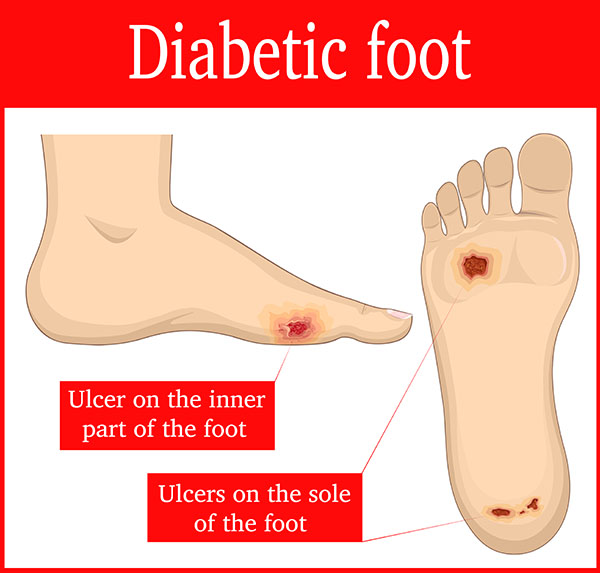Diabetic Foot
What are the symptoms and treatment?
Diabetic foot is a condition that can affect you at almost any age but it is more prevalent in seniors.
According to the Public Health Agency of Canada, roughly one in 10 adults in Canada (aged 20 or older) suffer from diabetes and the likelihood increases proportionally with age.
So does the chance of developing diabetic foot, with all its concerning possible complications (including the threat of amputation).
Let’s take a look at what diabetic foot is, the main causes and symptoms, and what you can do about it if you suffer from the condition.

What Is a Diabetic Foot?
Some of the most serious effects of diabetes are:
- The increased risk of heart attack and stroke
- Restricted blood flow to the extremities in the body (hands and feet)
- The damage done to various bodily systems, including the nervous system and renal system
With a diabetic foot, restricted blood flow and nerve damage cause the most harm.
A diabetic foot usually shows the signs of poor blood flow to the legs and feet, resulting in injuries that heal very slowly and that face a high risk of infection.
The problem is exacerbated by the numbness in the feet experienced by most people with the condition. They are unable to feel the full effects of heat, cold, or pain.
In people with diabetic foot, relatively innocuous injuries in otherwise healthy people (blisters, ulcers, or minor sores) can go undetected and develop into serious infected injuries.
What Does a Diabetic Foot Look Like?
The foot’s appearance will provide some tell-tale signs of diabetic foot. A physical examination is, therefore, the usual starting place for doctors.
A diabetic foot may become discoloured (with red streaks). One or both feet may also develop:
- Dryness
Fissures
A deformed appearance or abnormal shape
Calluses
Ulcers
Prominent veins
Nail lesions
Problems between the toes
Loss of hair on the dorsum (top area) of the foot
Staining on socks

What Does Diabetes Do To Your Feet?
The two main foot problems associated with diabetes are:
- Diabetic neuropathy – where nerve damage leads to numbness in the foot and insensitivity to pain or irritation (which, in turn, can lead to infections and other complications like gangrene.)
- Peripheral vascular disease – where the veins and arteries become blocked with fatty deposits (which restricts the blood flow and, in turn, leads to infections and slow wound healing.)
What Are The Signs Of Diabetic Feet?
The main signs of a diabetes-related foot condition are the physical irregularities described above.
These signs will vary from person to person but may also include:
- Feeling excessively warm or cold to the touch
- A lack of sensation in the foot (numbness)
- Pain or tingling in one or both feet
- Swelling of the foot
- Fever, chills or shaking – if a diabetic foot becomes infected
- Uncontrollable changes in blood sugar level (due to an infection of the foot)
What Causes Diabetic Foot?
Diabetic foot is caused by the side effects of diabetes: notably, high blood sugar levels that lead to restricted blood flow to the body’s extremities and nerve damage.
The nerve damage means that the foot is often numb to the sensation of pain so that otherwise “minor” problems like ulcers and sores can become infected without the diabetic person being aware of it.
When they fail to seek treatment, the infection quickly becomes a larger problem.
How Do You Treat Diabetic Feet?
Firstly, it’s very important to recognize the symptoms of diabetic foot and seek treatment immediately if you suspect it.
The threat of developing gangrene and suffering foot amputation should be uppermost in your mind if you have diabetes.
Over 50 percent of all foot amputations in the U.S. is because of diabetes.
A range of surgical and non-surgical options are available as treatments for diabetic foot.
As the first line of defence against developing complications:
- See a doctor
- Keep wounds clean and dressed
- Wear a cast boot or total contact cast to immobilize the foot
- Closely observe the foot for any signs of gangrene on the toes
If these steps are ineffective and complications develop, surgery may involve:
- The removal of decaying or dead tissue
- Amputation of toes or other foot sections (even the leg in severe cases)
- An arterial bypass to assist blood flow to the foot
- The placement of stents to open the blood vessels
Need More Information On Diabetic Feet?
Prevention is better than attempting to cure a diabetic foot.
If you’d like to read more tips on caring for your feet as a diabetic and how to treat the condition, check out our blog post on diabetic foot care tips.
All About Seniors provides personalized foot care for those with diabetes.
Our team of Certified Foot Care Specialists visit you at home to examine your feet and assist with your regular foot care routine.
All About Seniors is sensitive to your individual needs and preferences, and employ safe and gentle techniques.
